
Presonus Eris 4.5 BT MkII Studio Monitors/Speakers
$359.00
Make 4 payments of $89.75 over 8 weeks and get it now!
Make 4 payments of $289.50 over 8 weeks and get it now!
 PRESONUS TEMBLOR T10 ACTIVE 170WRMS 10" STUDIO SUBWOOFER WITH ERIS E5 STUDIO MONITOR BUNDLE
PRESONUS TEMBLOR T10 ACTIVE 170WRMS 10" STUDIO SUBWOOFER WITH ERIS E5 STUDIO MONITOR BUNDLE
To hear what's really going on at the bottom of your mixes, you need a subwoofer that speaks the truth. The Temblor T10 lets you take charge of the low-frequency 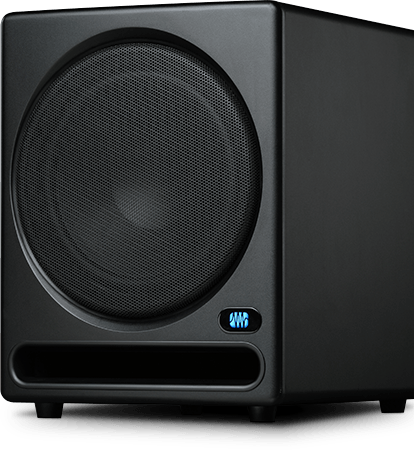 foundation of your mix with a combination of quality components and design, plenty of inputs and outputs, and extensive user controls not normally available in this price range.
foundation of your mix with a combination of quality components and design, plenty of inputs and outputs, and extensive user controls not normally available in this price range.
An ideal companion to Eris and Sceptre active reference monitors, the T10 complements full-range monitors without overshadowing them, extending the reach of your full-range systems low end with a musical and natural approach.
Powerful and musical, Temblor features high-quality components and design that enable it to deliver fast and accurate transient response, extending low frequencies without a hint of tubbiness or overshoot.
The Temblor T10 is an active subwoofer with a 10-inch glass-composite driver, built-in crossover, high-temperature voice coil, and damped rubber surround. Its cabinet features a front-firing, bass-reflex acoustic port and optimized, resonance-suppressing internal bracing. The enclosure has integrated rubber feet for stable placement.
In addition to outstanding accuracy and a frequency response that ranges from 20 Hz to 130 Hz, this combination of features enables the subwoofer to produce higher volume up to 113 dB SPL with less power than a sealed-box design. But make no mistake, the T10 has plenty of juice: 250 watts of Class AB power.
The result is a subwoofer that delivers accurate, tight low end and outperforms subs costing far more. With Temblor T10, you hear what the foundation of your mix really sounds like so you can produce your best mix from top to bottom.
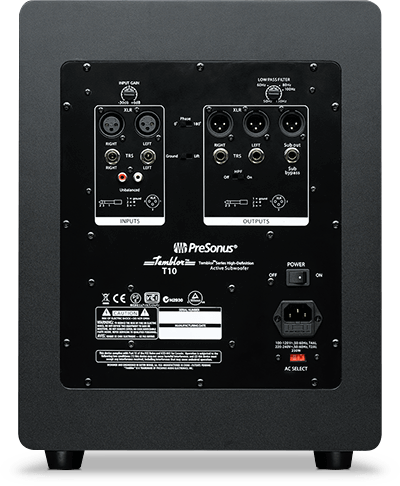
The T10 provides more user controls than any other subwoofer in its class, enabling seamless integration into your listening environment. The Temblor T10's extensive user controls include input gain (-30 dB to +6 dB, continuously variable) and a continuously variable lowpass filter (50 Hz to 130 Hz) that let you create a seamless crossover transition between your full-range studio monitors and subwoofer for a more accurate listening environment.
A switchable highpass filter removes frequency content below 80 Hz from the full-range signal sent from the T10 outputs to the main monitors, avoiding destructive cancellation and reinforcement in the T10s upper range.
The result is a subwoofer that can be adjusted to perfectly complement not only our Sceptre CoActual and Eris active studio monitors but virtually any studio monitor.
The T10 also features a momentary footswitch (included) that bypasses the subwoofer, highpass filter, and Sub Out. This allows your audio source signal to pass directly through the Temblor T10 to the full-range studio monitors, making comparing your mix with or without sub frequencies quick and easy. This helps to ensure your mix will sound good on a wide variety of systems.
Of course, we didn't forget the small things that can make a big difference: polarity invert and a ground-lift switch.
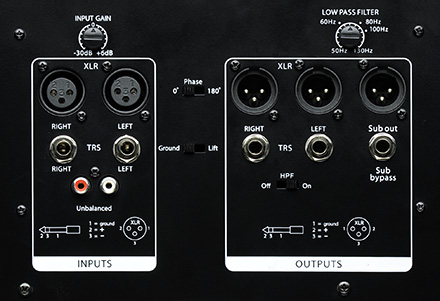
No other subwoofer anywhere close to the Temblor T10s price range offers a comparable selection of inputs and outputs.
The Temblor T10 provides a choice of three input pairs: two sets of balanced inputs (XLR and ¼ TRS) and one pair of RCA unbalanced inputs. Pairs of inputs are provided in order to accept a stereo signal from your audio source.
When both of the balanced connections are in use, the TRS inputs will take precedence over the XLR inputs. The RCA inputs will sum into either balanced connection.
You get two pairs of balanced outputs: XLR and ¼ TRS. The full-range signal connected to the stereo inputs on the T10 is passed through to these outputs so you can connect them to your main left and right studio monitors. If the High Pass Filter switch is engaged, frequencies below 80 Hz are not sent from these outputs.
The T10 also has a balanced XLR output that sends the low-frequency signal from the lowpass filter to a second Temblor T10 for the ultimate in smooth low end.
Inputs | |
| 2- Balanced XLR | |
| 2- Balanced ¼ TRS | |
| 2- Unbalanced RCA | |
Outputs | |
| 2- Balanced XLR (full range with 80 Hz HPF option) | |
| 2- Balanced ¼ TRS (full range with 80 Hz HPF option) | |
| 1- Balanced XLR (Sub Out) | |
Performance | |
| Frequency Response | 20 Hz to 200 Hz |
| Low Pass Filter Frequency | 50 to 130 Hz (variable) |
| Signal-to-Noise Ratio | >98 dB |
| THD | 0.019% @ power <160W |
| Amplifier Power | 170W RMS |
| Power Consumption | 230W |
| Amplifier Type | Class AB |
| Peak SPL at 1m | 113 dB |
| Woofer | 10" glass-composite |
Cabinet | |
| Vinyl-laminated MDF | |
Physical | |
| Width | 12.60" (320 mm) |
| Depth | 15.75" (400 mm) |
| Height | 15.75" (400 mm) |
| Weight | 39.46 lbs (17.9 kg) |
 PRESONUS ERIS E5 5" HIGH DEFINITION ACTIVE STUDIO MONITORÂ SPEAKERS (PAIR)
PRESONUS ERIS E5 5" HIGH DEFINITION ACTIVE STUDIO MONITORÂ SPEAKERS (PAIR)When you’re ready to get serious about recording, it’s time to step up to PreSonus Eris-series studio monitors. Cheap computer speakers and home-stereo speakers won’t reveal the truth about your mix. They aren’t designed for that.
In contrast, Eris speakers are real studio monitors, delivering a very accurate response with a tight bass and very clear upper end. That’s what you need in a home studio.
Notes Craig Anderton in his EM review of the E8 (March 2013), "The bass is tight and defined, with solid transient response, and the highs are accurate.... Accuracy is paramount in the studio, because transportability is crucial and the E8 scores high in that regard." Adds Strother Bullins (Pro Audio Review, September 2013), "Overall, the monitors are impressively frequency neutral with great imaging." Trevor Curwen (Future Music, July 2013) concurs: "Clarity is good and the overall balance of frequencies is one that you can work with, the top end coming through prominently and clearly revealing the detail, while the bottom end is tight and focussed and extends down far enough to allow you to make those important mix decisions."
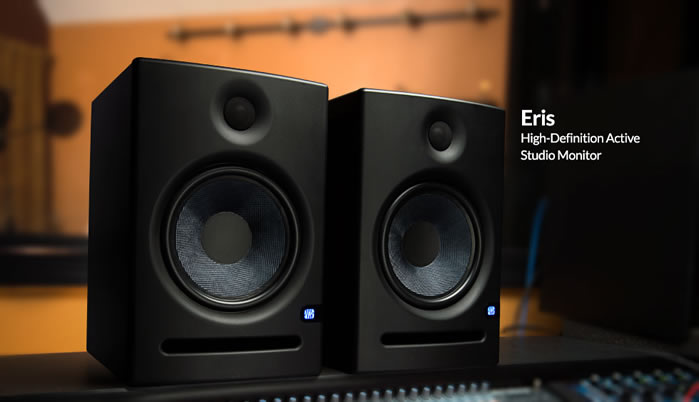
The E5 delivers less bass than the E8 but according to Recording magazine's Mike Metlay (March 2013), "The rolloff in the bass was polite and smooth, and there was a lot of thump in kick drums and solid harmonic structure in bass guitars and low piano notes.... Mids were forward and rockin’, with vocals and guitars prominent and detailed; on acoustic tracks, details like finger squeaks on strings and breaths for phrasing were clear and evident.... Highs were extended and smooth, without any edgy spikiness or resonances that leaped out; finger cymbals and hi-hats were clear and bright, and when an artist substituted a sample for the real thing, you could often tell."
Indeed, thanks to well-designed Kevlar® low frequency transducers, low-mass silk-dome tweeters, responsive Class AB amplification, and professional acoustic-adjustment controls, all Eris models deliver the goods.
Yet Eris-series speakers are ultra-affordable, making them a terrific value. And with two models, you can easily find the Eris monitor that best suits your studio needs.
If space is at a premium, or if you want the ultimate in portability, consider the compact Eris E5, which takes up just 7 x 10.24 x 7.68 inches (178 x 260 x 195 mm) and weighs in at just 10.2 lbs (4.63 kg). You can shoehorn this little beauty into almost any studio space.
The E5 sports a 5.25-inch, Kevlar low-frequency driver, mated with a 45W, Class AB amplifier; and a 1-inch (25 mm), silk-dome tweeter powered by a 35W, Class AB amplifier. It can crank out a clean 102 dB SPL, peak. Frequency response is rated at 53 Hz to 22 kHz. For a studio monitor in its size and price class, that’s impressive.
For an extended low-frequency response and a bit more muscle, step up to the Eris E8. With its 8-inch, Kevlar low-frequency transducer, driven by a 75 watt, Class AB power amplifier, it can range down to 35 Hz. Like the E5, the E8 can reach all the way to 22 kHz, thanks to a 1.25-inch (32 mm), silk-dome, high-frequency tweeter. However, the E8’s tweeter is driven by a heftier 65W, Class AB amplifier. With its extra juice, the E8 can deliver up to 105 dB SPL, peak.
All Eris speakers have front-ported enclosures made of vinyl-laminated, medium-density fiberboard (MDF).
Both Eris models provide balanced XLR, balanced ¼” TRS, and unbalanced RCA line-level inputs. When both balanced connections are in use, the TRS input will supersede the XLR input. The RCA input is summed into the signal path.
With this selection, you’ll have no problem hooking your Eris speakers up with virtually any line-level source. (If your signal source has unbalanced, ¼” TS outputs, simply use a ¼”-to-RCA adapter or adapter cable.)
Notes Media-Mixture.de (Germany), "For connections and adaptability to the space, PreSonus makes no compromises."
Today’s music producers deal with a wide variety of musical genres and often work in more than one location. It’s easy to take your Eris speakers with you when you want to work in a different space. It’s almost as easy to customize their sound for your room and type of music.
The most basic control is the Input Gain, which determines the signal level before it reaches the power amp. This is part of gain-staging your overall system that is, setting the levels for every part of the recording chain in order to get the optimal level of clean audio all the way through. Once you’ve gain-staged your system, you can leave this control alone.
The Eris E5/E8 provides three EQ controls in its Acoustic Tuning section: High, Mid, and Low Cutoff. These controls enable you to fine-tune the monitors and even to broadly approximate the sounds of different types of speakers so you can hear what your mix might sound like, for instance, on a car stereo or portable radio. The Low control also is useful when using the E5 or E8 with a subwoofer.
The Eris Acoustic Tuning controls let you customize the speaker’s sound with EQ. You get high-, mid-, and low-frequency bands.
The High control is a high-frequency shelving filter that boosts or cuts all frequencies above 4.5 kHz by as much as ±6 dB. Use this control to fine-tune the reproduction of high frequencies, depending on your room's acoustic characteristics.
In general, setting the High control to 0 (no boost or cut) will produce the best results. However, if the sound is generally too bright or shrill, try turning this control down below 0; if the sound is too dull and lifeless, try turning it up above 0. (In either case, check your mixer settings to see if anything’s amiss.)
Keep in mind that settings above 0 will also emphasize any high-frequency noise in the signal. It's always better to cut than to boost, if possible, and it's best to use the least cut or boost needed to get the job done.
The Mid control is a mid-frequency peak filter that boosts or cuts frequencies centered on 1 kHz and extending about one octave above and below that frequency. Again, setting this control to 0 will generally produce the best results.
If you want to emulate a car stereo, try turning the Mid control below 0 to approximate the common "smiley face" EQ curve. To emulate a cheap portable radio, try turning it up above 0. Try not to boost much, since this can add noise to the signal.
The Low Cutoff control rolls off the low frequencies below the specified frequency (selectable, 80 or 100 Hz) at a slope of -12 dB/octave. Engage this control if you are using a subwoofer in conjunction with the Eris E5/E8 monitors, and set it to the same frequency as the crossover to the subwoofer. If you're not using a subwoofer, set the control to Flat.
If you want to emulate a cheap radio, engage the Low Cutoff at 80 or 100 Hz while boosting the Mid control.
In addition to the Acoustic Tuning controls, Eris speakers offer a three-position Acoustic Space switch. This switch controls a second-order, low shelving filter that cuts the level of all frequencies below 800 Hz by a specified amount (-2 or -4 dB) to compensate for the boundary bass boost that occurs when the monitor is placed near a wall or corner. If you don’t want to roll off those lows, set it to 0 dB.
When a monitor is placed close to a wall, or in a corner, the low frequencies tend to be emphasized more than if the monitor is far from any room boundary; this effect is called "boundary bass boost." It is most pronounced if the monitor is in a corner and less pronounced, but present, if the monitor is near one wall. The effect is greater with rear-ported speakers than it is with front-ported speakers like the Eris, but it’s still a consideration.
To compensate for this bass boost, the Eris E5/E8 provides an Acoustic Space switch that cuts all frequencies below 800 Hz by a fixed amount. With this feature, you can control the bass response relative to the wall proximity of your speakers.
This combination of controls lets you create a linear response for accurate monitoring and enables you to simulate different listening environments, so you don’t have to listen to mixes on your car, consumer computer speakers, and home stereo to check how the music sounds with different systems. Instead, you can adjust the Eris monitors’ response and test your mixes without leaving your studio. No other monitors in this price class offer this degree of control.
Any loudspeaker is subject to an assortment of environmental and performance problems, and Eris monitors offer protection from most common of these. RF shielding protects against radio frequencies that could be induced into the signal and become audible. (If you’ve ever heard a radio broadcast unexpectedly coming out of a guitar amp, that’s the result of RF interference.)
Eris monitors also provide over-temperature protection to avoid heat-related issues, current-output limiting (to prevent damage should there be a short circuit on the speaker terminals), and subsonic protection to filter out extremely low-frequency vibrations that could interfere with the woofer’s performance.
Finally, Eris’ power amplifiers have a “soft startup” so that you don’t get damaging pops in the speakers when you power them up.
By now, it should be clear that Eris-series speakers deliver a lot more than you would expect from a budget-priced studio monitors. The reviewers agree. States Bullins (Pro Audio Review), "I find them to be an extreme bargain for what they provide the listener at under $500 per pair." Adds Metlay (Recording), "For your money you get monitors you can actually use for real engineering.... They bring honest-to-gosh studio monitoring into the price range of just about any studio, and they do it with class."
As you expect from PreSonus, Eris speakers use quality components, are well constructed, and deliver professional audio quality. They’re lightweight and compact and look as professional as they sound. "What you are getting here is a monitor that should fit tidily into most rooms and will let you hear the detail in your mixes," says Trevor Curwen (Future Music).
But what really sets them apart from comparably priced systems are user controls that allow you to tailor the speakers’ response to your needs. As Anderton notes (EM), "PreSonus’s 'special sauce' is the set of controls."
Don’t just take our word for it, though—or even the words of top reviewers. Visit your PreSonus dealer and hear the Eris E5 and E8 for yourself!
Inputs | |||
| Eris E81- Balanced XLR | ||
| 1- Balanced ¼” TRS | 1- Balanced ¼” TRS | ||
| 1- Unbalanced RCA | 1- Unbalanced RCA | ||
Performance | ||
| Frequency Response | 53 Hz - 22 kHz | 35 Hz - 22 kHz |
| Crossover Frequency | 3 kHz | 2.2 kHz |
| LF Amplifier Power | 45W | 75W |
| HF Amplifier Power | 35W | 65W |
| Peak SPL (@ 1 meter) | 102 dB | 105 dB |
| LF Driver | 5.25” Kevlar® | 8” Kevlar |
| HF Driver | 1” silk dome | 1.25” silk dome |
| Input Impedance | 10 | 10 |
User Controls | ||
| Volume Range | A-type taper | A-type taper |
| MF Control | -6, 0, +6 dB | -6, 0, +6 dB |
| HF Control | -6, 0, +6 dB | -6, 0, +6 dB |
| Low Cut | Flat, 80 Hz, 100 Hz | Flat, 80 Hz, 100 Hz |
| Acoustic Space | Flat, -2 dB, -4 dB | Flat, -2 dB, -4 dB |
Protection | ||
| RF interference | RF interference | |
| Output-current limiting | Output-current limiting | |
| Over-temperature | Over-temperature | |
| Turn-on/off transient | Turn-on/off transient | |
| Subsonic filter | Subsonic filter | |
| External mains fuse | External mains fuse | |
Power | ||
| 100-120V ~50/60 Hz or 220-240V ~50/60 Hz | 100-120V ~50/60 Hz or 220-240V ~50/60 Hz | |
Cabinet | ||
| Vinyl-laminated, medium-density fiberboard | Vinyl-laminated, medium-density fiberboard | |
Physical | ||
| Width | 7” (178 mm) | 9.84” (250 mm) |
| Depth | 7.68” (195 mm) | 11.77” (299 mm) |
| Height | 10.24” (260 mm) | 15.12” (384 mm) |
| Weight | 10.2 lbs (4.63 kg) | 22.2 lbs (10.07 kg) |
| SKU | T10E5 |
| Brand | PreSonus |
| Shipping Weight | 27.0000kg |
Help other Music Factory Direct users shop smarter by writing reviews for products you have purchased.

Presonus Eris 4.5 BT MkII Studio Monitors/Speakers
$359.00
Make 4 payments of $89.75 over 8 weeks and get it now!
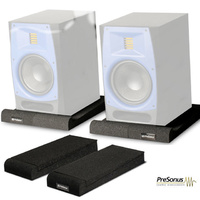
Presonus ISPD-4 Studio Monitor Speakers Isolation
$59.00
Make 4 payments of $14.75 over 8 weeks and get it now!
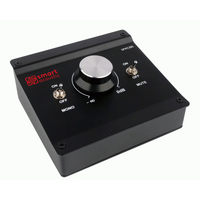
Smart Acoustic Passive Monitor Control SPMC200
$49.95
Make 4 payments of $12.49 over 8 weeks and get it now!
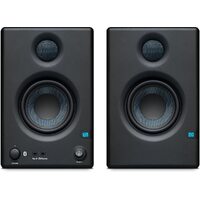
Presonus Eris 3.5 BT MkII Studio Monitors/Speakers
$289.00
Make 4 payments of $72.25 over 8 weeks and get it now!
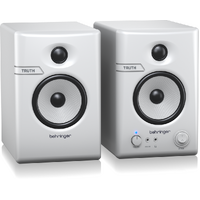
BEHRINGER TRUTH 3.5 BT-WH MONITORS WITH BLUETOOTH
$249.00
Make 4 payments of $62.25 over 8 weeks and get it now!

Italian Stage 15" bi-active two way speaker with M
$549.00
Make 4 payments of $137.25 over 8 weeks and get it now!
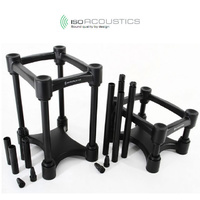
IsoAcoustics ISO-200 studio monitor speaker stands
$295.00
Make 4 payments of $73.75 over 8 weeks and get it now!
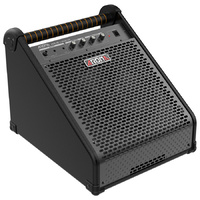
40W Electronic Drum Kit Amplifier Monitor Electric
$269.00
Make 4 payments of $67.25 over 8 weeks and get it now!